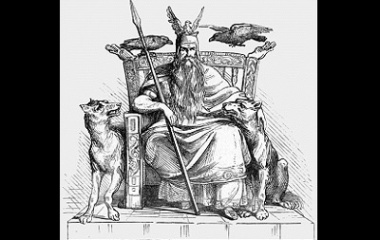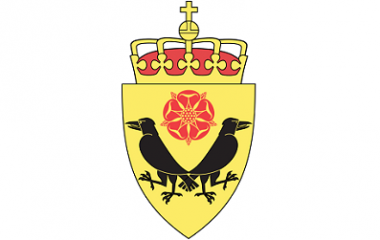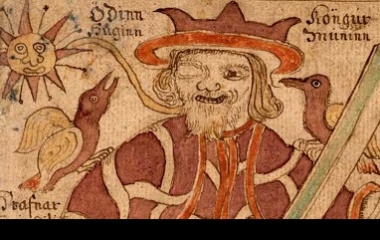Whether Odin is presiding over a grand banquet or galloping into the fearsome battle of Ragnarök, where he must meet his doom, he is always attended by Huginn and Muninn. These powerful ravens are much more than servants to Odin. Day after day, battle after battle, they prove themselves as trusted allies and inseparable friends.
What Are Huginn and Muninn?
Huginn and Muninn are a pair of ravens who, according to Norse mythology, are enlisted in Odin’s service. The birds depart every morning at dawn to fly around the Norse world, Midgard. At dinner, they return to their perches on Odin’s shoulders and tell him what they have seen.
Characteristics
Physical Description
Physically speaking, Huginn and Muninn don’t have much to set them apart from your garden variety raven. They are large, ominous looking birds with inky black feathers and big, sharp beaks. Their powerful wings can lift them high into the sky, while their beady eyes allow them to make out the landscape below in vivid detail.
Special Abilities
Although Huginn and Muninn might look like common ravens, they have been endowed by Odin with wonderful powers. First, the birds are able to fly the entire world of Midgard in a single day. Second, they have the ability to understand, and even speak in, the language of men. Third, they have extremely shrewd minds and wonderful powers of observation. The ravens are no mere spies for Odin; they are important advisors and confidants too.
Huginn and Muninn can also accompany Odin into battle, where they inform him of his enemy’s movements and help him guide and heal his horse.
Relationship with Odin
Some scholars interpret Huginn and Muninn as projections of Odin himself, rather than common ravens whom he has blessed with special powers. In Norse culture, it was common for shamans to enter a trance-like state, during which they sent their consciousness to probe the world and bring back information. Odin’s ravens’ names (Huginn meaning “thought” and Muninn meaning “desire or mind”) support the idea that they are projections of his consciousness. It’s no great stretch of the imagination to believe that Odin, the leader of the gods, could project his “thought” and his “mind” in the same way that a shaman could and that the ravens are simply symbols of his omnipotence.
Other scholars believe that Huginn and Muninn are Odin’s fylgjur. In Norse culture, spirit animals, called fylgjur, are commonly seen in the company of great men and women. These animals are manifestations of the person’s character. Someone with a fox as a fylgja is sly and cunning, while someone with an ox as a flygja is strong but tame. Ravens embody wisdom and guidance in Norse culture, so a god with two ravens as his flygjur would be a wise guide—just like Odin.
Fylgjur are often tied into a person’s fate as well; they tend to show up just before a climactic moment in the person’s life, and they are often omens of death. Huginn and Muninn frequently appear in depictions of Ragnarök, the great, apocalyptic battle where Odin is doomed to die. The ravens warn him of the event and remain on his shoulders during the battle.
Finally, some scholars believe that Huginn and Muninn are Odin’s hamingja, a physical embodiment of his luck. In Norse culture, the spirit is made up of many, separable parts that can be sent on different errands. The hamingja is one of those parts, and because it is not one of the most essential parts of the spirit, it is often deployed on small missions.
History
Archaeological Record
Ravens litter the archaeological digs that have given us much of our knowledge about Norse culture. Across nine centuries and four countries, these birds have reigned supreme as Norse symbols, flying around Odin’s head or perched on his shoulders.
The ravens appear in golden amulets, helmet plates, and shoulder brooches, dated back to the fifth, sixth, and seventh centuries. They grace the Oserberg Tapestry, which was found aboard a ninth-century Viking funeral ship, and they perch on Thorwald’s Cross, a rune stone from the eleventh century. Sweden, Denmark, Norway, and even England have all yielded evidence that local people called upon Huginn and Muninn for power and guidance.
Literature
Huginn and Muninn appear in some of the earliest, definitive texts on Norse Culture. Their black shapes can be found soaring through the Poetic Edda, a 13th century compilation based on traditional folklore, as well as The Prose Edda, the Heimskringla, and the Third Grammatical Treatise, where they are seen cozying up to Odin on his shoulder.
Explanation of the Myth
It’s no coincidence that Huginn and Muninn, a pair of almighty ravens, were hatched from Norse culture. Not only are ravens powerful and common symbols in Norse folklore, they played an important role in the everyday life of Norse people, too.
Perhaps the first link between Norse people and ravens was their eating habits. Early Norse people were hunters and gatherers, while ravens were carrion feeders. A clever raven might trail a hunter for a day, and when he made a kill, invite himself to the feast. Likewise, a hungry hunter might notice a raven circling in the sky and follow it to a ready meal. In this way, a primitive bond may have formed between Norse people and ravens.
As time went by and Norse civilization advanced, people began embarking on the famous sea voyages that would win Norse culture a glorious place in history—and they took their allies, the ravens, with them. Just as ravens once guided the Norse people to food, they were now relied upon to guide their boats to land. The mighty birds were carried in cages on Viking ships. At regular intervals, they were taken from their cages and tossed into the sea breeze to scout out the boat’s surroundings. If the bird found land, it would head that way instead of returning to the ship. If it didn’t find land, it would return to the ship.
Because they played such an important role in the everyday lives of Norse people, ravens began to be revered by the people. After guiding hundreds of Norse people to food and safety, it’s little wonder that these great black birds found their way onto Odin’s shoulders!











thanks great ideas for homework 🙂